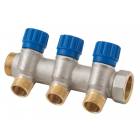Materials that form heating headers
Heating headers are designed using materials such as brass combined with specific percentages of alloy elements

Heating headers are obtained by plastic deformation of a metal at a temperature higher than the typical recrystallization temperature of that metal. In reality we speak specifically of recrystallization because the microstructural change takes place within a fixed temperature range.
Gnail Bocia headers are in brass CW617N,with a 57-59% percentage of copper,between 1.6 and 2.5% of lead,maximum tin 0.3%, impurities around 0.2% and the rest is made up of zinc.
The fact that these alloy elements are added in precise percentages means that each alloy element implies the modification of the physical and mechanical properties of the headers and the result must be an improvement. Metal,for example, refines the grain increasing the maximum tensile stress, aluminium increases rust resistance. Lead generally improves the processing at machine point, placing itself at the grain edge and facilitating the breakdown of metal shavings. For this reason a small percentage is always added.The addition of alloys causes a structural modification equivalent to the addition and subtraction of zinc equivalents.For these reasons there are calculated indexes of zinc equivalents with which appropriate evaluations can be carried out in order to obtain the best heating headers.
Gnail Bocia headers are in brass CW617N,with a 57-59% percentage of copper,between 1.6 and 2.5% of lead,maximum tin 0.3%, impurities around 0.2% and the rest is made up of zinc.
The fact that these alloy elements are added in precise percentages means that each alloy element implies the modification of the physical and mechanical properties of the headers and the result must be an improvement. Metal,for example, refines the grain increasing the maximum tensile stress, aluminium increases rust resistance. Lead generally improves the processing at machine point, placing itself at the grain edge and facilitating the breakdown of metal shavings. For this reason a small percentage is always added.The addition of alloys causes a structural modification equivalent to the addition and subtraction of zinc equivalents.For these reasons there are calculated indexes of zinc equivalents with which appropriate evaluations can be carried out in order to obtain the best heating headers.
28/08/2013
I contenuti di questo sito non hanno carattere di periodicità e non rappresentano 'prodotto editoriale'.









